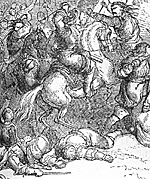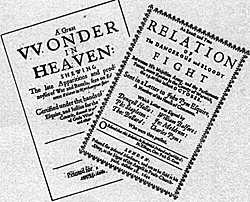
If there is any truth in the theory that events involving violence and strong emotion imprint themselves on the surrounding atmosphere, and can be later seen in the form of ghostly apparitions, it is feasible to suppose that battles, on land, sea or in the air, could be seen in this spectral form. There is evidence supporting this supposition, evidence coming from many reports of long past scenes of war, or more recent ones at the time, being thus re-enacted. Some of these re-enactments have occurred in England.
Although Britain as a whole has enjoyed comparative internal peace since Culloden in 1746, it was not previously so fortunate. Several longer or shorter wars, lesser military campaigns, isolated conflicts, etc, were constantly breaking out over many centuries. Many are the hauntings attributed to their aftermath.
Edgehill Hauntings
One major example of such an aftermath happened during the Civil War between the Royalist and the Parliamentarians. This is a war which has left behind it a considerable store of supernatural manifestations. There is a striking example of this sort of phenomena in the first major battle of this campaign, the Battle of Edgehill.
This is probably the most interesting case of all the hauntings related to this period.
The greater part of the information concerning this particular episode was contained in a pamphlet published immediately after the relevant events. It did, therefore, provide first hand eye witness accounts given in sworn testimony, and by a number of people living in the district at the time.
The first occasion mentioned was on December 23rd, 1642, two months after the actual Battle of Edgehill was fought. Between midnight and one o'clock of that Saturday morning a group of shepherds and travellers were abroad in the countryside near to Edgehill. Suddenly they heard the sound of distant drums, far away, ant then drawing nearer to them, followed by trumpets and human voices.
The people were, naturally, thoroughly alarmed. They were preparing to make a quick departure from the scene when a strange vision was added to strange sound. A weird phenomen became visible in the air, just above ground level. Two armies, with ensigns flying and horses neighing, were facing each other. One of these armies displayed the colors of the King, the other the colors of Parliament.
Spectral Battle
They stood there, facing each other, in the lower part of the sky as if some ground not of this earth was underneath them.
The King's horsemen, the renowned Cavaliers, made the first charge, whereupon the battle at first appeared to be going in their favor. Then fortunes swayed. The Parliamentarians, due to the prowess of their foot soldiers, began to gain the advnatage. The battle raged, with the clattering of arms, the roar of cannon, the clarion call of trumpets,and the moans f the wounded anddying.
The spectacle was terrifying to the sight of those who watched, for they realized that what they saw was not a manefestation of this World.
As one of them said later, they dare not move from the spot where they stood for fear of becoming prey to the phantom soldiers. Instead they stayed to witness the retreat of the Royalist forces at the end of a bloody, but inconclusive, fight.
The Parliamentary forces remained in the field for some time after the departure of their opponents, displayed all the sights and sounds of victory, and then disappeared as suddenly as they had arrived, by simply fading into that proverbial thin air.
The terrified spectators, then released from their rooted to the spot awe inspired ordeal, rushed at once to the nearby town of Kineton. There they roused from his slumbers a magistrate by the name of William Wood, and the minister, one Reverend Samuel Marshall. The reluctant sightseers told their amazing tale to these two gentlemen. Being intrigued, and perhaps a little incredulous, about what they had heard, the magistrate and the minister decided to keep watch with their informants in the same place the following night. Made aware of the facts, several other local notabilities were sufficiently interested to join them in the vigil.
Whatever doubts the newcomers to the case might have entertained were soon dispelled. for they saw the battle fought again, exactly as on the previous night.
The watch was also kept on the following nights. but nothing happened; not immediately. No ghostly battle was manifest until the Saturday night. Then, and on the Sunday night, the battle was re-enacted in its entirety.
The whole business preyed so much on the minds of the magistrate, Mr. Wood, and some of his friends, that they moved away from their homes in the haunted district and went elsewhere, hoping that distance would make them more secure from, supernatural manifestations than staying in the midst of them. The minister was, apparently, made of sterner stuff. for he remained on watch with a few other stout hearted individuals.
Sure enough, the battle took place on the next Saturday and Sunday nights. It should be noted that, according to the evidence later given, there was never any variation in the details of the spectral battle and how it was fought. The days on which it occurred may also be relevant, as the actual earthly engagement was on a Sunday.
Charles I Investigates
At this time, King Charles I was holdting court at Oxford, where the news of these remarkable events were conveyed to him. His Majesty promptly called upon Colonel Lewis Kirke, Captain Dudley, Captain Wainmore, and three other officers to investigate the matter. The reasons given for the setting up of this on-the-spot commission of enquiry were the prevention of the spreading of alarm amongst the population of the district, and to check the identity of the combatants in the unearthly battle, particularly those who were well known to the officers in the commission and who had fallen on Edgehill field.
The officers first heard the testimony of the minister, and other available witnesses, and then kept watch on the scene themselves. On the following Saturday and Sunday nights they not only saw the entire phantom battle being fought, but recognised amongst the combatants of their personal friends who had been killed in action at Edgehill.
Pamphlets
 The news got around. The pamphlet consequently published
and which recorded and thus made wider known the preceeding
concluded with these words:
The news got around. The pamphlet consequently published
and which recorded and thus made wider known the preceeding
concluded with these words:
-
"What this doth portent, God only knoweth, and time will perhaps
discover, but doubtless this is a sign of His wrath against this land for
these civil wars, which He in His good time finish and send a sudden
peace between His Majesty and Parliament."
Unfortunately, this was not to be so. and much bloodshed and misery were to follow during the course of the Civil War, with consequences in some measure still continuing to the present time. If the phantom battle was intended as a warning against the repetition of such a wholesale slaughter on this Earth, it was not successful. If it signified that what is past and gone, whether for good or evil in a material world, still exists in another sphere, and can at times be revealed to the living, and maybe as a reminder of the Evil the human race can do, then the importance of this and similar manifestations is not to be lightly disregarded.
Back to English Civil War Times No. 52 Table of Contents
Back to English Civil War Times List of Issues
Back to Master Magazine List
© Copyright 1997 by Partizan Press
This article appears in MagWeb (Magazine Web) on the Internet World Wide Web.
Other military history articles and gaming articles are available at http://www.magweb.com